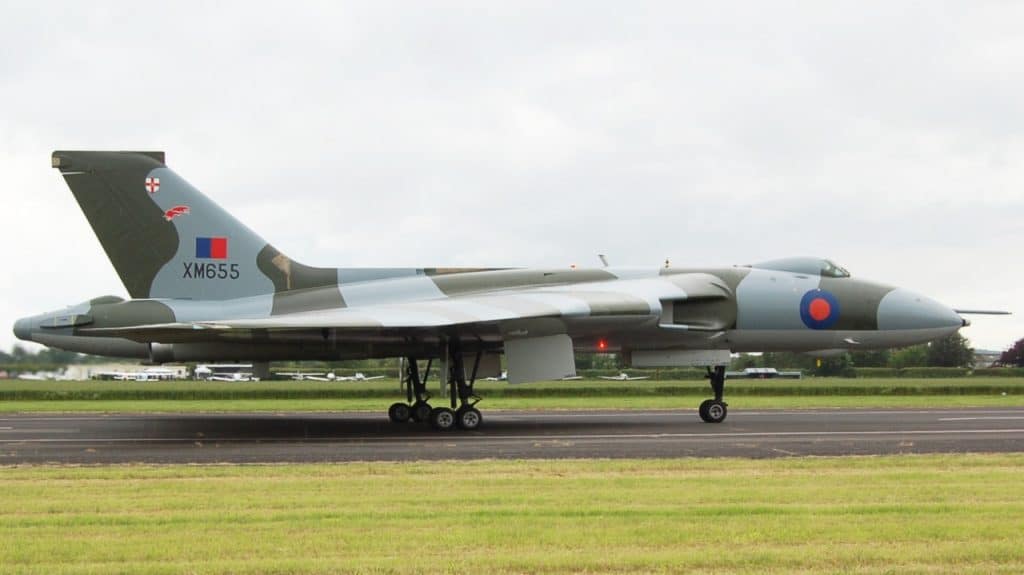The historic Avro Vulcan B.2 bomber, number XM655, suffered an accident today while taxiing at Wellesbourne Mountford Airport in central England. For an undetermined reason, the machine ran over the threshold of the lane and stopped just in front of the road. There is currently no information on the exact damage it has sustained, but it is most likely not serious. The crash, however, forced the cancellation of the event planned for the day after tomorrow at the airport.
The XM655 is no longer airworthy, but can still taxi on its own, and its owners – who also own the airport – occasionally organize shows where Vulcan presents to the public on the move. Today’s ill-fated taxiing was part of the preparations for the last performance this year, which is also to commemorate the famous “Black Buck” operations during the Falklands War.
Oops. Vulcan bomber at Wellesbourne airfield has just overshot the runway during a hot taxi run. Almost made it to the road. pic.twitter.com/CMoIFSIinp
– Lloyd, not Llyod (@ Lloydyy22) September 16, 2022
-ADVERTISEMENT-

There are currently only three Vulcans in the UK that are currently maintained in a taxiable condition – along with the XM655, these are the XL426 at London Southend and the XH558 at Doncaster Sheffield (which it will have to leave soon and it is unclear what will happen to it). The XH558 The Spirit of Great Britain was the last flight-capable bomber of its type. Unfortunately, his career in the air irrevocably – for safety reasons – ended in 2015.
The renovation of the HX558 ended in 2007 and it has been the star of all the air shows it has appeared at since then. Initially, it seemed that the last show season for the XH558 would be 2013, but thanks to financial support from people of goodwill, it was possible for a cost of £ 400,000 to complete the most urgent modification, installing aluminum reinforcement panels on the leading edges of the wings. From the beginning, it was assumed that this would be enough to extend Vulcan’s life by two years (hence the project was called “Operation 2015”), but everyone hoped that during this time it would be possible to find a cure for other pressing problems and add at least a year.
Oooops !!! Vulcan to the hedge 😂 @scan_sky pic.twitter.com/douZmodH9j
– Mike 🤙🏼 (@ mikey_9fingers) September 16, 2022
Unfortunately, the three companies whose experts oversee the technical condition of the XH558 agreed that this was no longer possible and refused to provide further support, and without it, the British Civil Aviation Authority would not allow Vulcan to continue flying. Of course, the situation was not improved by the lack of spare parts (especially for engines) and the decreasing number of people who have experience in working with machines of this type (pensioners have been working on the machine for some time).
While the XH558 was built relatively early in the Vulcan production cycle (roughly one third), the XM655 was one of the last machines released from the production line. After that, only two copies (XM656 and XM657) were built at the Woodford plant. Both airframes no longer exist, making the XM655 the youngest Vulcan to date and the only one powered by Bristol Olympus 301 engines.
The XM655 began service with the Royal Air Force at RAF Cottesmore in 1964. Then he was assigned to RAF Waddington. After the RAF was removed from the status of the RAF (it had a flight time of only 5744 hours), the XM655 ended up in the hands of businessman Roy Jacobsen, who initially wanted to maintain its flightworthiness, but the investment exceeded his financial capacity and the plane began to deteriorate. The owners of the Wellesbourne Mountford airport took over the machine to cover its parking costs for several years in 1993. Shortly thereafter, the XM655 fell victim to vandals that devastated the cabin.
The machine has been presented to the public on the ground since February 1997. Some time later it also became a kind of trainer for the crews and mechanics working on the XH558. Until the COVID-19 pandemic put an end to such events, the XM655 taxied in front of viewers generally once or twice a year. The screenings resumed last September.
See also: The historic B-17G Nine-O-Nine has crashed
Alec Wilson, Creative Commons Attribution-Share Alike 2.0 Generic

